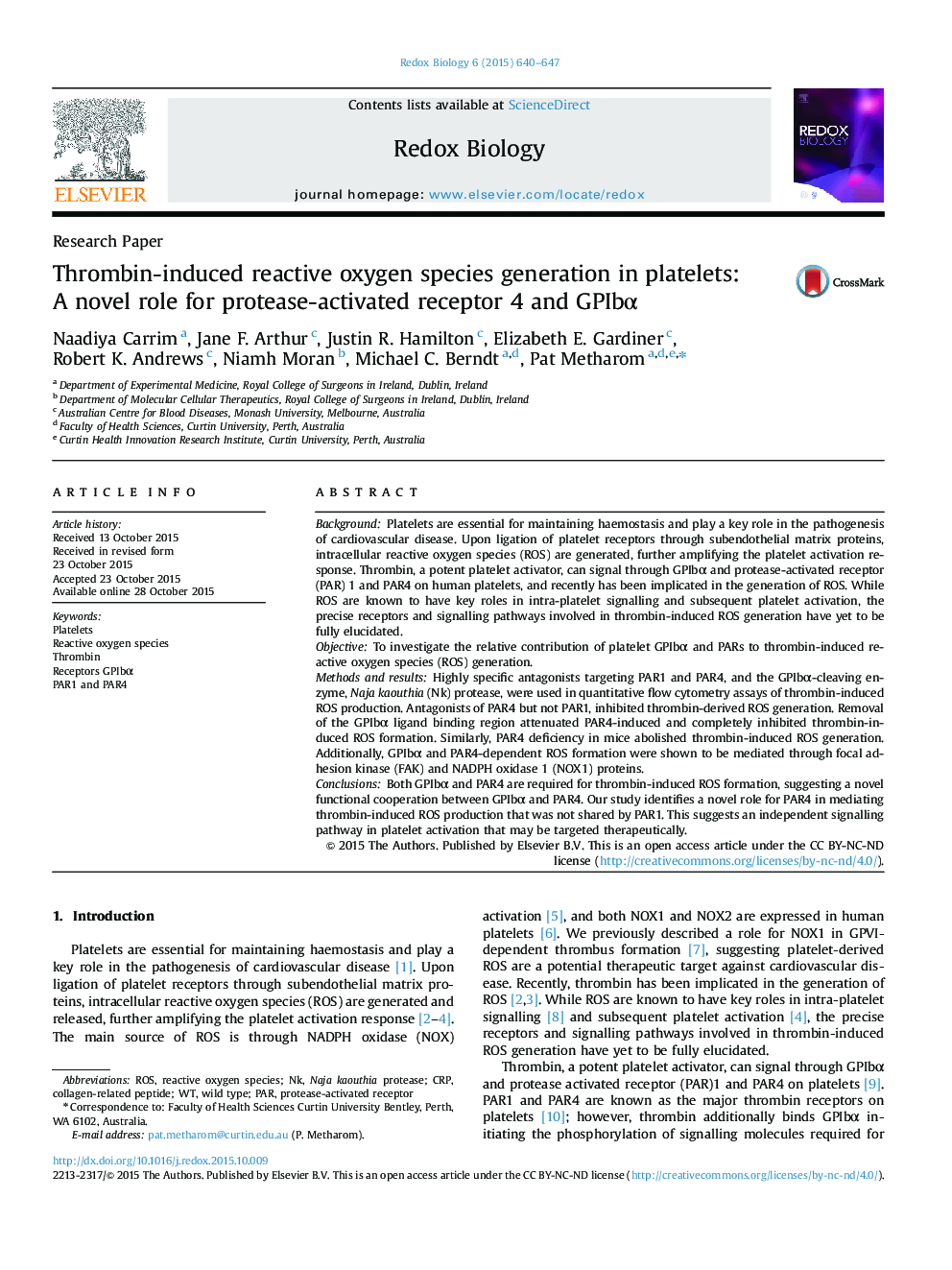| کد مقاله | کد نشریه | سال انتشار | مقاله انگلیسی | نسخه تمام متن |
|---|---|---|---|---|
| 1922954 | 1535844 | 2015 | 8 صفحه PDF | دانلود رایگان |

• PAR4 plays an important role in platelet-derived ROS generation.
• Thrombin-induced ROS generation in platelets require both GPIbα and PAR4.
• Potential functional association between GPIbα and PAR4 receptors and mouse and human platelets.
• GPIbα and PAR4-dependent ROS formation is mediated through FAK and NOX1 proteins.
BackgroundPlatelets are essential for maintaining haemostasis and play a key role in the pathogenesis of cardiovascular disease. Upon ligation of platelet receptors through subendothelial matrix proteins, intracellular reactive oxygen species (ROS) are generated, further amplifying the platelet activation response. Thrombin, a potent platelet activator, can signal through GPIbα and protease-activated receptor (PAR) 1 and PAR4 on human platelets, and recently has been implicated in the generation of ROS. While ROS are known to have key roles in intra-platelet signalling and subsequent platelet activation, the precise receptors and signalling pathways involved in thrombin-induced ROS generation have yet to be fully elucidated.ObjectiveTo investigate the relative contribution of platelet GPIbα and PARs to thrombin-induced reactive oxygen species (ROS) generation.Methods and resultsHighly specific antagonists targeting PAR1 and PAR4, and the GPIbα-cleaving enzyme, Naja kaouthia (Nk) protease, were used in quantitative flow cytometry assays of thrombin-induced ROS production. Antagonists of PAR4 but not PAR1, inhibited thrombin-derived ROS generation. Removal of the GPIbα ligand binding region attenuated PAR4-induced and completely inhibited thrombin-induced ROS formation. Similarly, PAR4 deficiency in mice abolished thrombin-induced ROS generation. Additionally, GPIbα and PAR4-dependent ROS formation were shown to be mediated through focal adhesion kinase (FAK) and NADPH oxidase 1 (NOX1) proteins.ConclusionsBoth GPIbα and PAR4 are required for thrombin-induced ROS formation, suggesting a novel functional cooperation between GPIbα and PAR4. Our study identifies a novel role for PAR4 in mediating thrombin-induced ROS production that was not shared by PAR1. This suggests an independent signalling pathway in platelet activation that may be targeted therapeutically.
Both GPIbα and PAR4 are required for thrombin-induced ROS formation, suggesting a novel functional cooperation between GPIbα and PAR4. (A) Thrombin binds GPIbα, via the sulphated tyrosine sequence, and cleaves PAR4, activating the signalling molecules FAK and NOX1 and generating ROS. B. Nk protease cleaves GPIbα and inhibits thrombin-induced ROS generation, whilst hindering PAR4-induced ROS production. In the presence of the PAR4 antagonist, tcY-NH2, PAR4-AP-induced ROS production is abolished. GP: glycoprotein; PAR: protease activated receptor; FAK: focal adhesion kinase; NOX: NADPH oxidase; ROS: reactive oxygen species; Nk: Naja kouthia; AP: activating peptide.Figure optionsDownload as PowerPoint slide
Journal: Redox Biology - Volume 6, December 2015, Pages 640–647